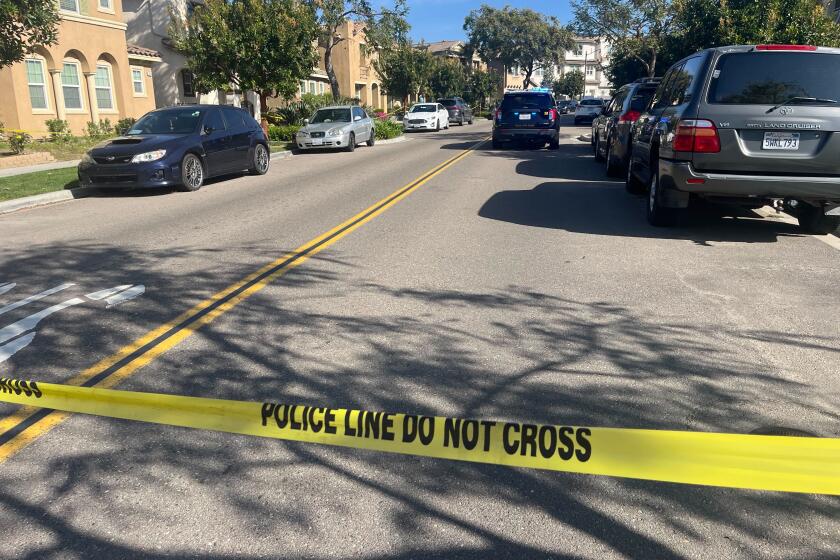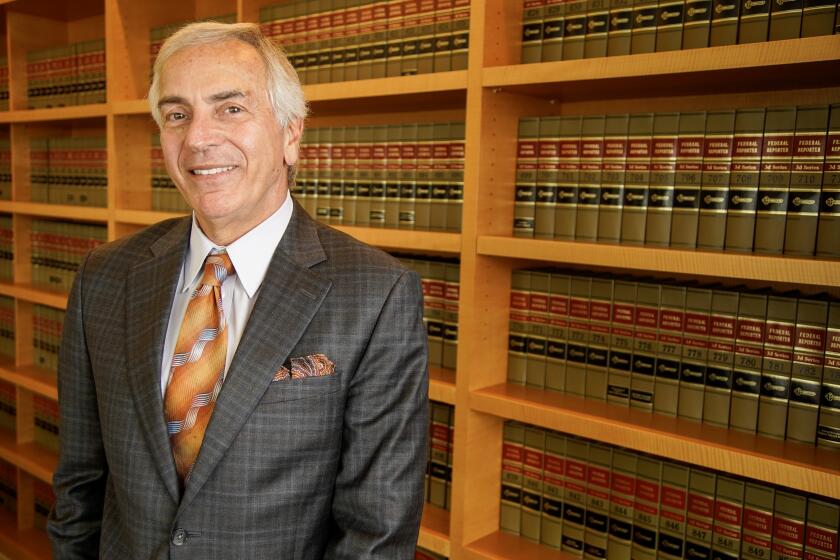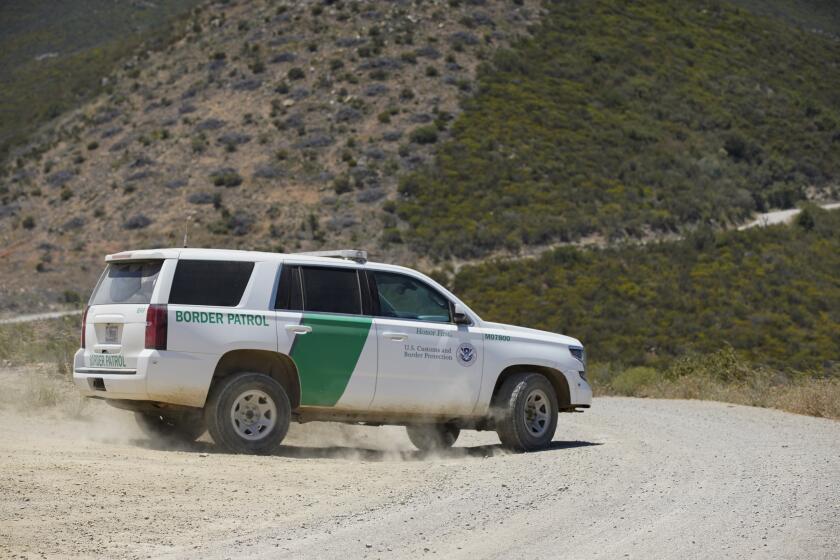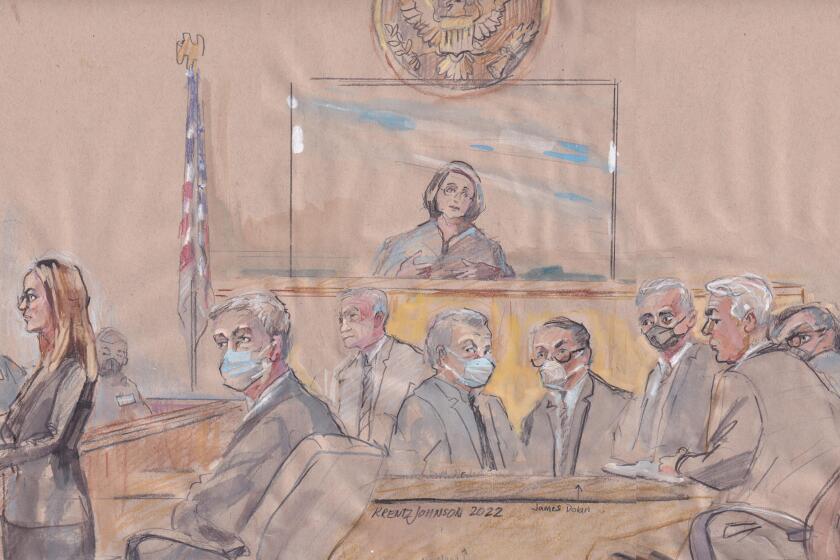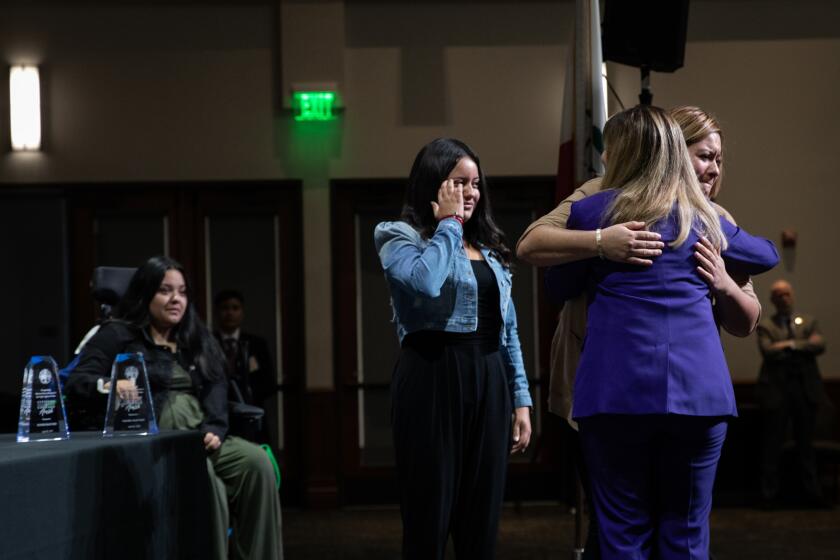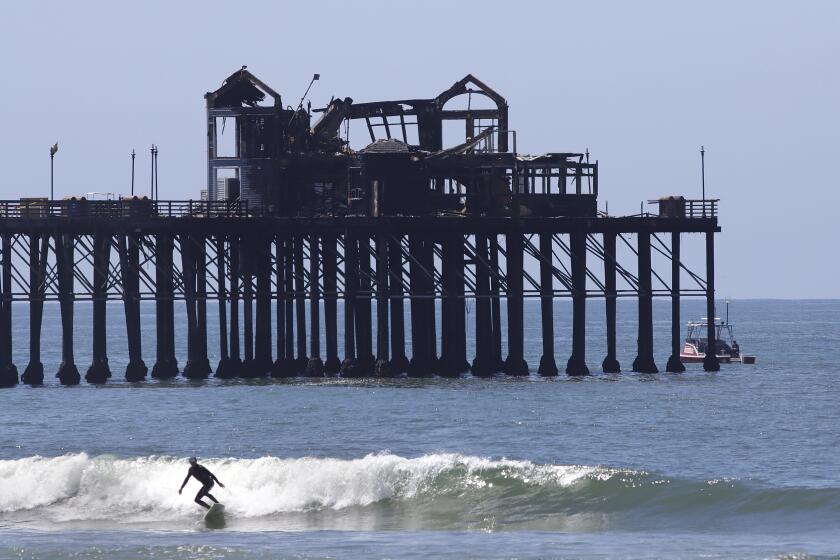Tijuana drug violence bleeds into San Diego County with recent cartel shootings

A high-ranking member of an Arellano Félix Organization remnant cell was gunned down near UTC. Then a man who Mexican authorities say is a reputed leader was shot in Chula Vista.
Three shootings that left two people dead and three wounded over the past couple of months in San Diego County were linked to Mexican drug cartels and involved a drug cell embroiled in a vicious dispute with its rivals in Baja California, according to sources with knowledge of cartel activity and the ongoing investigations.
One of the shootings wounded James Bryant Corona, an alleged drug cell leader with dual U.S.-Mexican citizenship, according to sources on both sides of the border with knowledge of the investigation. Baja California Deputy Attorney General Rafael Orozco Vargas described Corona as “one of the main generators of violence” in Tijuana and greater Baja California.
Another attack killed 35-year-old Christian Espinoza Silver, a reputed member of the same drug cell, after a gunman opened fire on him inside a BMW near the parking garage of a pricey high-rise apartment complex in University City.
This story is for subscribers
We offer subscribers exclusive access to our best journalism.
Thank you for your support.
Sources said those targeted in the shootings were linked to a remnant cell of the Arellano Félix Organization, or AFO, a cartel that once dominated Tijuana before the group was largely dismantled more than a decade ago by federal authorities in San Diego. Orozco Vargas, second-in-charge of the state prosecutor’s office, confirmed that Corona, who is known as “El Apache,” has worked under an AFO leader known as “Cabo 20,” who is currently in Mexican custody.
While Tijuana and Baja California have for decades been plagued by such violence related to organized crime, rarely in recent years has it bled over so publicly and brazenly into San Diego County, sparking concern among some U.S. authorities and those familiar with Mexican drug trafficking organizations.
“The influence and crime committed by cartels has been, and continues to be a serious issue in our county, as it has been for many years,” San Diego County District Attorney Summer Stephan told the Union-Tribune in a statement. “The threat remains a significant concern.”
Steve Duncan, a retired agent from the California Department of Justice who spent decades investigating the Arellano Félix Organization and other cartel-related figures in San Diego and Tijuana, including Espinoza, said that cartels “know killing people on this side of the border is bad business.”
And yet, Duncan and others say cartel-related violence here is not as rare as some San Diegans might think. “This type of cross-border violence is not new — the evidence for that is super long,” said Michael Lettieri, the managing editor of the Mexico Violence Resource Project. Lettieri pointed out that the AFO previously “recruited their worst enforcers from the U.S. side of the border,” referring to the Logan Heights street gang members indicted more than 25 years ago for working as assassins for the cartel.
Lettieri said the San Diego-Tijuana region is a cross-border community in which people and goods move back and forth, usually for the good, but sometimes also for the bad.
“That flow is natural ... (but) has meant that there are always connections to organized crime,” Lettieri said. “We are the market for the drugs.”
Even so, the recent shootings were worrisome to some.
“The only thing that’s keeping (the violence) from getting out of control here is we have integrity in our system,” Duncan said, adding that it’s important that investigators share information and solve the shootings. “It has to be investigated and prosecuted ... We have to set an example.”
The FBI and Drug Enforcement Administration — the agencies that typically investigate drug trafficking organizations — declined to comment on the recent violence. An FBI spokesperson said federal law and agency policy “prohibits the routine confirmation of the existence of investigations.” A DEA spokesperson referred questions to Chula Vista police, who are investigating two of the shootings.
Three shootings
The first attack occurred Feb. 17 when a gunman opened fire on a BMW SUV near the parking garage of Palisade UTC, a high-end apartment complex considered one of the most expensive in the county when it opened in 2019. Espinoza was struck multiple times and killed, according to San Diego police. Duncan said Espinoza, known as “El Chato,” was a well-known figure in the Tijuana drug trade with longstanding ties to the Arellano Félix cartel.
Christian Espinoza Silver, 35, was fatally shot multiple times in a parking garage on Saturday. Investigators are attempting to find the gunman and motive behind deadly attack.
A 39-year-old man inside the SUV with Espinoza was also struck multiple times and wounded, San Diego police said. Police have not announced any arrests in connection with the shooting.
Two more shootings occurred just hours apart last month in Chula Vista, one the night of March 26 outside a Chili’s restaurant in a strip mall parking lot off East H Street and Paseo del Rey, and the other early on March 27 at the Salerno Luxury Rentals apartment complex in the Otay Ranch neighborhood.
Two teens were arrested following an early-morning shooting that left one man dead and another shot in the face at the Salerno Luxury Rentals apartment complex
The person wounded outside the restaurant was Corona, known by his moniker “El Apache,” according to sources on both sides of the border with knowledge of the investigation. The sources spoke to the Union-Tribune on the condition of anonymity because of the ongoing investigation. The same sources said the shooting less than five hours later at the Otay Ranch apartments was related to the shooting of Corona.
Neither Espinoza nor Corona have been charged with any crimes in the U.S. But Orozco Vargas, the Baja California prosecutor, said Corona is on the radar of Mexican law enforcement.
“We do not have an arrest warrant against him, however, he is always in the sights of the authorities because he is the main generator of violence in the city,” Orozco Vargas said Tuesday. “The problem that we have, not only with him, but with several who are identified and who are generally known to be leaders of (criminal) groups, is that they are not the ones who are executing people in the street ... They are at a level where the crimes they commit are federal.”
Mexico’s federal Attorney General’s Office, which prosecutes drug crimes, said Espinoza had not been charged or previously convicted, and the office did not respond to questions about Corona.
Chula Vista police spokesperson Sgt. Anthony Molina did not identify Corona as the victim wounded outside the Chili’s, but said that just after 8:50 p.m., a man in his 40s was shot in the leg outside of the restaurant and then walked inside, prompting several 911 calls. Molina said medics transported the man to a hospital with injuries that were not life-threatening.
The subsequent shooting less than five hours later at the Salerno apartments left one person dead and a 24-year-old man with a gunshot wound to his face, Molina said. Investigators have not released the name of the man who was killed or additional details about him.
Detectives arrested two 15-year-old boys on suspicion of attempted murder in connection with the apartment shooting. Due to their age, little information has been released about the teens, but court officials said they were arraigned April 2 in Juvenile Court. Juvenile hearings are typically closed, though judges have the discretion to allow media to attend in newsworthy circumstances. A judge denied the Union-Tribune’s request to attend.
“The victims in this case and their families are paramount as we embark on a prosecution in juvenile court and continue the investigation into anyone responsible for harming our community,” Stephan told the Union-Tribune. “Arrests in this particular case have been made and this is an ongoing investigation. Federal, state and local law enforcement will continue to collaborate closely and are dedicated to pursuing justice in these matters to keep San Diego one of the safest urban counties in the nation.”
Border City is a new LA Times Presents podcast from The San Diego Union-Tribune.
Cartel faction feuds
Duncan, the retired California Department of Justice special agent, said Espinoza’s family has had ties to the Arellano Félix brothers and their criminal organization dating back decades. Orozco Vargas, the Mexican prosecutor, said Corona previously worked under David López Jiménez, known by the nickname “Cabo 20.” López was arrested and charged in 2022 on suspicion of murder, and prosecutors have also said he is suspected of ordering the murder of Tijuana photojournalist Margarito Martínez Esquivel, although he has not been charged in that case.
Their Tijuana-based Arellano Félix cell is reportedly allied with one of the two main factions of the powerful Sinaloa cartel, according to University of San Diego’s Justice in Mexico project. That cartel is roughly split between those loyal to “Los Chapitos,” four of the sons of imprisoned drug lord Joaquín “El Chapo” Guzmán, and those loyal to Guzmán’s longtime business partner, Ismael “El Mayo” Zambada.
The long simmering rivalry between the Arellano Félix cell and one of the Sinaloa cartel factions was on public display last year in a pair of competing “narco banners” — the handwritten signs that cartels affix in public places, sometimes accompanying murder victims, to threaten rivals. One, attributed to the Sinaloa cartel and found draped over a corpse in Tecate, said in part: “This is what will happen to everyone who supports Brian James Corona ‘El Apache,’” according to Mexican media reports.
Then in November, corrupt police officers in Tijuana allegedly stole a drug shipment reportedly belonging to the “El Mayo” faction of the Sinaloa cartel, the Associated Press reported, citing Baja California state prosecutors. The AP, as well as Zeta Tijuana, an investigative magazine, reported that in the days and weeks after the drug shipment disappeared, Sinaloa cartel assassins hunted, shot and killed several of the law enforcement agents thought to be involved. Zeta also reported that the police officers who stole the drugs colluded with members of the Arellano Félix cell.
Since that time, the reputed top leader of the Arellano Félix cell was shot and injured in Tijuana, Espinoza was gunned down in University City and Corona was shot in Chula Vista.
Duncan said Espinoza escaped an attack by masked gunmen in 2005 by jumping out of the window of a Tijuana banquet hall during a quinceañera. The assassins killed one of Espinoza’s family members, Raúl Silver Quintana, who some media have reported was his father, though Duncan said he was his uncle. Duncan said Espinoza has often hidden out in San Diego over the better part of the past 20 years.
U.S. and Mexican officials have said some of the four Arellano Félix brothers also hid out in the U.S. in the 1990s.
Erubiel Tirado, a security expert and professor at Mexico’s Universidad Iberoamericana, said cartel violence in a U.S. border city would be a “huge change” in the pattern of how criminal trafficking organizations operate.
“Traditionally American cities ... were ... kind of sanctuaries (for) the kingpins and some important members of each dominant Mexican organization,” Tirado wrote in an email. “In that sense, the non written rule was do not ‘heat’ (those) territories with violence and criminal activities.”
Lettieri, from the Mexico Violence Resource Project, said the recent violence being reported likely represented outlier cases and not the start of a pattern. He warned about reading too much into the cause of such violence.
“This kind of thing happens from time to time when certain things shift that we, as outside analysts, don’t have access to,” Lettieri said. He added that the theory of the stolen drug shipment “is the kind of thing that could provoke this. But whether we ever really know why is another question.”
Duncan said the shootings reminded him of the “Los Palillos” case that he helped investigate more than 15 years ago. Investigators and prosecutors said that group — named after the Spanish word for toothpick — broke off from the Arellano Félix Organization and operated in San Diego County, where they killed at least nine people, including cartel rivals, in a kidnapping and ransom scheme that sometimes enlisted local street gangs. The two top leaders of the group were each sentenced to multiple life terms in prison.
Union-Tribune editor Kristina Davis contributed to this report.
The latest news, as soon as it breaks.
Get our email alerts straight to your inbox.
You may occasionally receive promotional content from the San Diego Union-Tribune.
